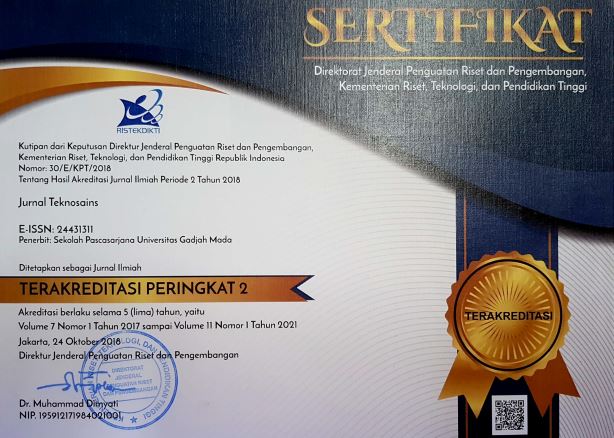Proses difusi relativistik melalui persamaan langevin dan fokker-planck
Arista Romadani(1*), Muhammad Farchani Rosyid(2)
(1) Fakultas Sains dan Teknologi, UIN Maulana Malik Ibrahim Malang
(2) Fakultas Matematika dan Ilmu Pengetahuan Alam, Universitas Gadjah Mada
(*) Corresponding Author
Abstract
Brownian motion theory is always challenging how to describe diffusion phenomena with the main issue is how to extend the classical theory of Brownian motion to the special relativity framework. In this study, we formulated dynamics and distribution of a Brownian particle in relativistic framework by using Langevin and Fokker-Planck equation. By representing Brownian particle dynamics by Langevin equation, the velocity curves were dependent on the presence of viscous friction coefficient (heat bath), and were used generalized in special relativity theory, A relativistic Langevin equation reduces to the classical theory at low velocities. Likewise, the distribution of Brownian particles is represented as a stationary solution of the relativistic Fokker-Planck equation. From numerical results, we found that the probability density in the relativistic Fokker-Planck equation for was reduced to the standard Fokker-Planck equation in Netownian classical theory. For the calculation result showed that the Hanggi-Klimontovich approach has a consistent result to the relativistic Maxwell distribution. This work could open a promising interpretation to formulate the diffusion phenomena into general relativity theory.
Keywords
Full Text:
PDFReferences
[1] S. D. Jacka and B. Oksendal, “Stochastic Differential Equations: An Introduction with Applications,” Journal of the American Statistical Association, 1987, doi: 10.2307/2288814.
[2] J. Pitman and M. Yor, “A guide to Brownian motion and related stochastic processes,” arXiv: Probability, 2018. arXiv:1802.09679
[3] J. Perrin, "Mouvement brownien et molécules," Journal of Physics: Theories and Applications, 1910, 9 (1), pp.5-39. ff10.1051/jphystap:0191000900500ff. ffjpa-00241577f
[4] P. S. Pal and S. Deffner, “Stochastic thermodynamics of relativistic Brownian motion,” New Journal of Physics 22 073054, 2020, https://doi.org/10.1088/1367-2630/ab9ce6
[5] G. E. Uhlenbeck and L. S. Ornstein, “On the theory of the Brownian motion,” Physical Review Journal, vol. 36, no. 5, pp. 823–841, 1930, doi: 10.1103/PhysRev.36.823.
[6] P. Whittle and L. Arnold, “Stochastic Differential Equations: Theory and Applications,” Journal of the Royal Statistical Society Series A (Statistics in Society), vol. 139, no. 3, p. 409, 1976, doi: 10.2307/2344856.
[7] K. Itô, “Stochastic integral,” Proceedings of the Imperial Academy, vol. 20, no. 8, pp. 519–524, 1944, doi: 10.3792/pia/1195572786.
[8] K. Itô, “Multiple wiener integral,” Journal of the Mathematical Society of Japan, vol. 3, no. 1, pp. 157–169, 1951, doi: 10.2969/jmsj/00310157.
[9] J. Dunkel and P. Hänggi, “Relativistic Brownian motion,” Physics Reports, vol. 471, no. 1. pp. 1–73, 2009, doi: 10.1016/j.physrep.2008.12.001.
[10] P. Langevin, “Sur la theorie du mouvement brownien”, Comptes Rendus de l'Académie des Sciences, 1908.
[11] D. S. Lemons and A. Gythiel, “ Paul Langevin’s 1908 paper ‘On the Theory of Brownian Motion’ [‘Sur la théorie du mouvement brownien,’ C. R. Acad. Sci. (Paris) 146 , 530–533 (1908)] ,” American Journal of Physics, 1997, doi: 10.1119/1.18725.
[12] F. Debbasch, K. Mallick, and J. P. Rivet, “Relativistic Ornstein-Uhlenbeck process,” Journal of Statistical Physics, vol. 88, no. 3–4, pp. 945–966, 1997, doi: 10.1023/b:joss.0000015180.16261.53.
[13] J. Dunkel and P. Hänggi, “Theory of relativistic Brownian motion: The (1+3)-dimensional case,” Physical Review E - Statistical, Nonlinear, Biological, and Soft Matter Physics, vol. 72, no. 3, 2005, doi: 10.1103/PhysRevE.72.036106.
[14] J. Franchi and Y. Le Jan, “Relativistic diffusions and schwarzschild geometry,” Communications on Pure and Applied Mathematics vol. 60, no. 2, pp. 187–251, 2007, doi: 10.1002/cpa.20140.
[15] F. Debbasch, “Relativistic stochastic processes: A review,” AIP Conference Proceedings 861, 488 (2006); https://doi.org/10.1063/1.2399614
[16] J. Dunkel and P. Hänggi, “Theory of relativistic Brownian motion: The (1 + 1)-dimensional case,” Physical Review E - Statistical, Nonlinear, Biological, and Soft Matter Physics vol. 71, no. 1, 2005, doi: 10.1103/PhysRevE.71.016124.
[17] A. Romadani, “Proses Difusi Relativistik Pada Kasus (1+3)-Dimensi,” UGM, 2013.
[18] V. N. G. Kampen, Stochastic Processes in Physics and Chemistry. 2007. Elsevier Science
[19] P. Hänggi and H. Thomas, “Stochastic processes: Time evolution, symmetries and linear response,” Physical Reports pp. 207–319, 1982, https://doi.org/10.1016/0370-1573(82)90045-X
[20] F. Jüttner, “Das Maxwellsche Gesetz der Geschwindigkeitsverteilung in der Relativtheorie,” Annals of Physics Journal vol. 339, no. 5, pp. 856–882, 1911, doi: 10.1002/andp.19113390503.
[21] R. Tsekov, “Brownian motion of molecules: the classical theory,” Annual University of Sofia Faculty of Chemistry vol. 88, no. 1, 2010, arXiv:1005.1490v3 [Statistical Mechanics]
Article Metrics
Refbacks
- There are currently no refbacks.
Copyright (c) 2022 Arista Romadani, Muhammad Farchani Rosyid

This work is licensed under a Creative Commons Attribution-ShareAlike 4.0 International License.
Copyright © 2024 Jurnal Teknosains Submit an Article Tracking Your Submission
Editorial Policies Publishing System Copyright Notice Site Map Journal History Visitor Statistics Abstracting & Indexing









